WINDROWING CANOLA - IMPACT ON HARVEST LOSSES AND QUALITY
| Date: 16 Sep 2010
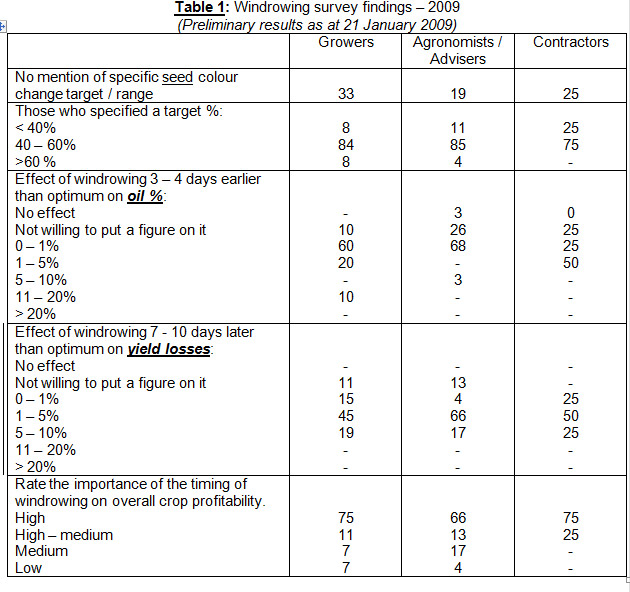
Introduction
Anecdotal evidence from growers, advisors and agronomists in central western NSW repeatedly referred to inconsistent timing of canola windrowing, usually earlier than recommended, as a common practice. The implications of early windrowing timing were perceived by some to be of no consequence and others to be a major issue.
This project aimed to gain a better understanding of prevailing knowledge, attitude, skills and practices to identify areas where further work could address any issues. It comprised of 4 parts: a survey of growers, advisers/agronomists and windrower contractors; a canola phenology study, canola crop case study and an inspection survey of canola paddocks post harvest.
Industry guidelines
Canola industry Best Management Practice (BMP) recommends that the ideal time to windrow canola is when between 40 – 60% of seeds on the main stem have changed colour. At this stage, seed moisture content is between 30 and 35%. This usually happens around 20 to 30 days after the end of flowering. (The ‘end of flowering’ is designated to be when the crop has only 10% of plants with flowers remaining).
Canola plants mature from the bottom pods up. Windrowing needs to occur before these pods shatter. Depending on seasonal conditions and grain moisture content, windrowed crops are ready to harvest 5 to 14 days after windrowing.
PART 1: Windrowing survey
A survey was carried out by phone and face-to-face interviews to determine common practices, knowledge and attitudes. Growers, consultants/advisers and agronomists, and local contractors were contacted.
Some of the key findings included:
• Yield loss from pod shattering was the principal concern when determining the ideal time to windrow.
• The effect of windrowing timing on the degree of oil penalty was a strong concern, however the majority of individuals had little confidence in identifying specific changes in oil %.
• Most people were aware that oil accumulation in the seed continued during late seed development.
• Descriptions of how crops are assessed to determine the optimum windrowing time varied widely, from quite ambiguous with a more generalized approach to very detailed explanations of where to look in the crop, sampling approach, examination within the plant canopy; bottom middle or lower pods, main stem vs. branches etc
• For some, there was more emphasis on pod colour change, rather than seed colour change.
• The most frequently mentioned areas of additional information that were sought included:
- improved understanding of how windrowing timing effects oil %;
- information to assess the timing of windrowing effects on the value of additional oil vs. value of shattering losses including margins of error;
- comparing direct heading vs. windrowing;
- variety differences in pod shattering and changes in pod colour, and
- assessment of commercial products to reduce shattering levels when direct heading.
PART 2: Paddock inspections
An inspection of 52 paddocks in central western NSW was carried out after the 2009 harvest to assess harvest losses. The number of seeds on the ground both where the windrow had lain as well as between windrows was estimated and the cutting height of the crop was also measured.
Crop development, windrowing and harvest details were also collected for the majority of paddocks.
Some of the key findings included:
• ‘End of flowering’ to the date of windrowing ranged between 14 and 38 days, with most crops within the narrower range of 25 to 33 days.
• Windrows remained in the paddock between 8 and 19 days before harvest, with most between 10 to 16 days (Figure 1).
• Most growers felt the stage of crop maturity at which they windrowed was ideal and would not have changed the date of windrowing, given the option again (Figure 1).
• Shattering losses under the windrow were mostly in the range 25 – 50 kg/ha. Between the windrows, losses were lower, generally 25 kg/ha or less.
• The overall value of seed on the ground ranged between $11.31 and $77.45 /ha (Figure 2).
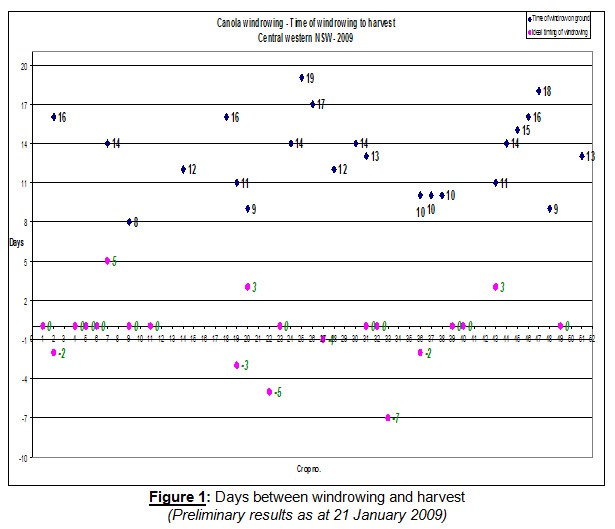
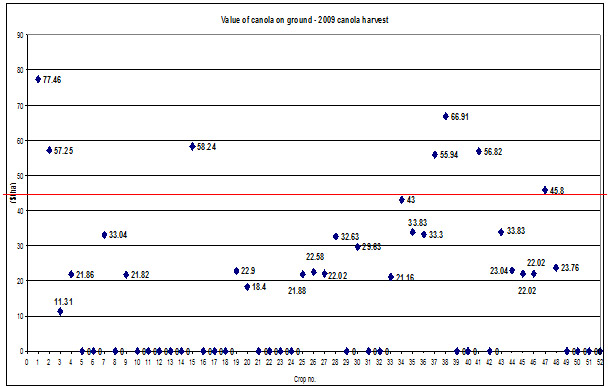
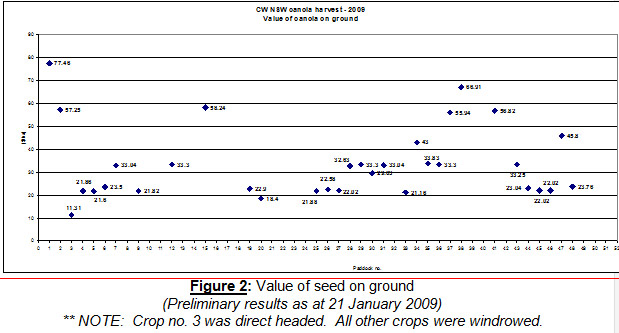
Crop physiology
Understanding crop growth and development and general crop physiology supports the implementation of recommended BMPs. Closer examination of individual crops and varieties shows the effects of local environmental conditions on plant growth and development and assists in understanding the subsequent outcomes at harvest.
PART 3: Case study
(NOTE – This does not contain replicated data)
A crop of 46C78 canola sown 2 July 2009 at “Cumboogle” Dubbo, the property of Chris Taylor, was inspected and sampled every 3 days during the post flowering period until windrowing. Two separate areas of the crop, one under irrigation, the other dryland were sampled. Temperatures were recorded at hourly intervals during this period.
Flowering commenced 6 October in both areas, however limited soil moisture in the dryland area caused flowering to cease 7 days earlier than the irrigated area.
Temperatures during most of the flowering period, a time when pod and seed development is determined were unseasonably mild with mean daily temperatures below 25ºC. The extended flowering period of the irrigated crop was characterized by low periods of gradual temperature increases during seed development.
Oil production
Carbohydrates, products of plant photosynthesis are transferred from the leaves and pod walls to the seeds. Developing embryos consist of the radicle (root) and cotyledons (seedling leaves). Cotyledons contain chlorophyll and through photosynthesis, contribute to oil production. Oil production commences between 2 and 3 weeks after pollination. Cotyledon size increases rapidly from 2 weeks to maturity.
As the seed embryo continues to grow, oil is progressively accumulated, following an ‘S’ curve pattern. The rate of oil accumulation is most rapid several weeks after pollination, before declining as the seed approaches maturity. At this stage the embryo and therefore oil content make up the majority of seed dry matter content. At maturity, 80% of the oil is in the cotyledons.
Figure 3 shows the mean oil content of the seed 32, 35, 38 and 41 days after the beginning of flowering. The irrigated crop is still accumulating oil at a faster rate compared to the dryland crop which has already plateaued.

How does this change the value of the crop over this period? Table 2 shows there was generally little change in the value of the seed in the dryland crop as oil deposition within the seed had more or less ceased.
Under the better moisture conditions of the irrigated crop, with mean daily temperatures in the low to mid 20ºC’s, oil was still accumulating between 7 and 10 November at an average oil value of $1.87 /day (an additional $5.60 over the 3 day period). This was cut short however with daily maximum temperatures over 40ºC after 10 November, effectively shutting down seed metabolic processes and no further oil was produced

Seed size
Seed dry weight continues to increase as the seed matures and loses moisture. Table 3 shows the general trend for increasing seed size during the final stages of seed maturation in both crops.
The more favourable moisture condition in the irrigated crop contributed to a faster rate of seed size increase compared to the dryland crop.
Colour change
Limited soil moisture and increasing daily temperatures hastened crop maturity. The rate of seed colour change between the crops reflected crop moisture stress with seeds in the middle pods changing from 65 to 100% colour change in the dryland crop compared with 2 to 60% in the irrigated crop within a 3 day period (Figure 4).

PART 4: Canola phenology
(NOTE – This does not contain replicated data)
In environments where high temperatures frequently coincide with moisture stress, varieties that flower and complete seed development, fill and accumulate oil before the growing season is cut short are considered essential. Local data is central to developing recommendations that incorporate practical risk management.
Figure 5 shows the relative differences between 3 canola varieties sown on 5 sowing dates in 2009. Canola has a strong response to daylight and temperature. Late sowing decreases the duration of vegetative development and increases the risk of flowering occurring in hot dry spring conditions, thereby decreasing overall potential yields.
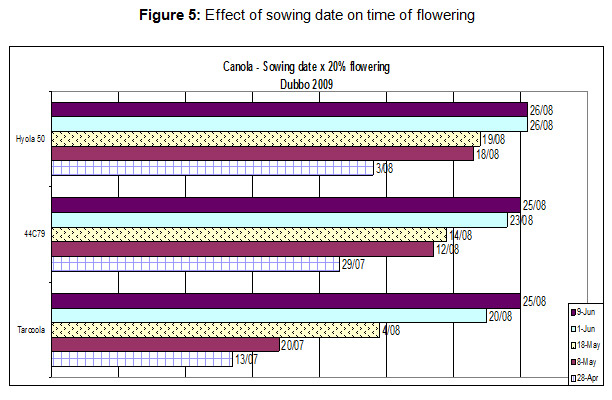
Figure 6 demonstrates the effects of sowing date on canola seed size and oil content. The canola was grown under conditions of high available moisture; however increasing daily temperatures also prevailed, effectively reducing the overall duration of seed growth and development, including oil accumulation.

Conclusions
Windrowing is an important management practice used to optimize harvest management and crop quality. This project has shown a snapshot of local practices and their effects on crop performance.
Some discrepancies have been revealed in knowledge and general understanding of the effects on timing of windrowing on yield and oil content amongst growers, advisors, agronomists and contractors.
The degree of the consequences of poor windrowing timing was unknown, however opinions varied widely.
Applying the principles of BMP’s can be compromised by practical issues like the availability of the windrower.
Acknowledgements
Special thanks to Chris Taylor “Cumboogle” - Dubbo, Michael White, Michael White & Co – Wellington
Local growers, contractors, agronomists and advisers who gave their time and co-operation
TAFE NSW – Rural Skills Centre, Dubbo
Paddy Steele, Neil Fettell – I&I NSW
Contact details
Kathi Hertel
Industry & Investment NSW
PO Box 865, DUBBO NSW 2830
Ph: 02 6881 1276
Fax: 02 6881 1295
Mob: 0427 104 344
Email: kathi.hertel@industry.nsw.gov.au
Was this page helpful?
YOUR FEEDBACK
